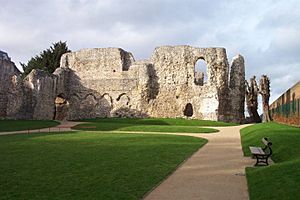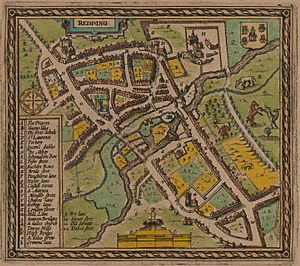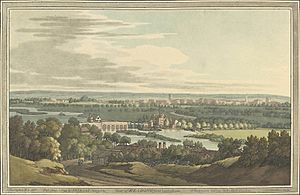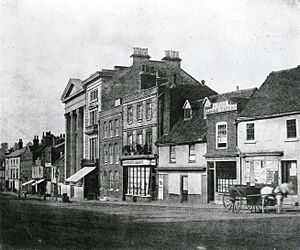History of Reading, Berkshire facts for kids
Reading, a town in England, might have been a busy place even during the time of the Romans. It could have been a trading port on the River Thames or a stop on a Roman road that connected London to another Roman town called Calleva Atrebatum near Silchester.
Contents
Early Days of Reading
The first clear signs of Reading as a town appeared in the 8th century. Back then, it was known as Readingum. This name came from an Anglo-Saxon tribe called the Readingas. Their name means "Reada's People" in Old English, and "Reada" likely meant "The Red One."
In late 870, an army of Danes invaded the kingdom of Wessex and set up camp in Reading. On January 4, 871, the first Battle of Reading happened. King Ethelred and his brother Alfred the Great led an army but could not break through the Danes' defenses. This battle is written about in the Anglo-Saxon Chronicle. This old book gives us the first known written record that Reading existed. The Danes stayed in Reading until late 871, then they moved to London for the winter.
After the Battle of Hastings and the Norman Conquest of England, William the Conqueror gave land in Reading to Battle Abbey. In the 1086 Domesday Book, Reading was clearly called a borough, which means it was an important town. The book also noted that Reading had six watermills. Four of these mills were on the king's land, and two were on the land given to Battle Abbey.
Reading Abbey's Influence
Reading Abbey was started by King Henry I in 1121. He was even buried there. King Henry gave the abbey his lands in Reading and at Cholsey. He also arranged for land that used to belong to Battle Abbey to be given to Reading Abbey. In return, Battle Abbey received some of his land in Sussex.
The founding of Reading Abbey made the town a popular place for pilgrimage (religious journeys). This helped Reading become richer. However, the people of Reading, called burgesses, sometimes had problems with the Abbey. In 1253, Reading's Merchant Guild successfully asked the King for a special charter. This charter helped them share power with the Abbey. But arguments continued, especially about the Abbey's right to collect taxes and choose the Guild's leaders. Even the title of the Guild's main leader was debated. The Guild and sometimes the King called him the Mayor, but the Abbey still called him the Guild Warden.
We don't know exactly how badly Reading was affected by the Black Death. This terrible sickness swept through England in the 1300s. But we do know that the abbot of Reading Abbey, Henry of Appleford, died from it in 1361. A nearby town, Henley, lost 60% of its people.
In 1487, King Henry VII gave Reading another charter. This charter gave the town more rights, but the Abbey still chose the Mayor or Warden. This charter, and a later agreement in 1499, officially made the Guild a permanent, legal group.
Changes and Conflicts
The Abbey was mostly destroyed in 1538 during Henry VIII's time. This was part of the dissolution of the monasteries, when King Henry VIII closed many religious houses. The last abbot, Hugh Cook Faringdon, was found guilty of high treason and hanged in front of the Abbey Church. After the Abbey closed, the King's officers chose the Mayor. But in 1542, Henry VIII gave the Guild a new charter. This allowed the people of Reading to elect their own Mayor.
By 1525, Reading was the biggest town in Berkshire. Tax records show it was the 10th largest town in England based on its wealth. By 1611, Reading had over 5,000 people. It became rich from its cloth trade, as shown by the wealth of local merchant John Kendrick. Most houses in Reading at this time were made of timber. Some examples can still be seen today. Often, the ground floor of a house was a shop, with the family living upstairs.
Reading played a big part in the English Civil War. The town changed hands many times. Even though it had fortifications, a Royalist army was placed there in 1642. The Siege of Reading by the Parliamentary forces succeeded in April 1643. However, the taxes collected by both sides left Berkshire in a terrible state. The town's cloth trade was badly damaged. Reading's economy did not fully recover until the 20th century.
Reading was also important during the Revolution of 1688. The second Battle of Reading was the only major fight of this time. King James II had placed 600 soldiers, mostly Irish, in Reading. They were meant to stop William's army from marching to London. The people of Reading saw these soldiers as an invading force. They asked William for help and told him where James's soldiers were. As a result, about 250 of William's soldiers attacked from an unexpected direction. They forced the Irish troops to leave the town. This defeat, and the people of Reading helping William, convinced James that his position was not safe, and he fled the country.
Reading in the 1700s
The 1700s saw a large iron works begin in Reading. The brewing trade also grew, which Reading later became famous for. Farm products from nearby areas still came to Reading as a market. The famous Reading cheese fair was a big event. Trade also started coming from a wider area.
Reading's trade improved because of better turnpike roads. These roads helped Reading become a major stop on coaching routes from London to Oxford and the west country. The town also benefited from more river traffic on both the Thames and Kennet rivers. In 1723, the Kennet Navigation opened the River Kennet to boats as far as Newbury. This was despite many people in Reading being against it at first. But they changed their minds when they saw how the new route helped the town. The opening of the Kennet and Avon Canal in 1810 made it possible to travel by barge from Reading all the way to the Bristol Channel.
From 1714, and maybe even earlier, Reading and Abingdon shared the role of county town for Berkshire. The Assize and Quarter Sessions courts met in both towns. The Lenten Assizes were usually held in Reading, and the Summer Assizes in Abingdon. The county gaol (jail) was in Reading. Both towns also had a house of correction, which held prisoners from different parts of the county.
Towards the end of the century, Henry Addington, 1st Viscount Sidmouth, lived near Reading. He later became prime minister. He gave the town of Reading four acres of land, which is now the Royal Berkshire Hospital. His name is remembered in the town's Sidmouth Street and Addington Road.
Reading in the 1800s
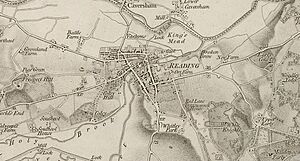
In 1801, Reading had about 9,400 people. During the 1800s, the town grew quickly as a place where many things were made. Reading kept its two members of parliament after the Reform Act 1832. It also became a municipal borough in 1835. In 1836, the Reading Borough Police force was started. The Great Western Railway arrived in 1841. Then came the South Eastern Railway in 1849, and the London and South Western Railway in 1856.
The Reading Establishment was an early photography studio. It operated in Reading from 1844 to 1847. It was run by Nicholaas Henneman, who used to work for William Fox Talbot, a photography pioneer. Many pictures for Fox Talbot's book, The Pencil of Nature, were printed in Reading. This was the first book ever to use photographic prints.
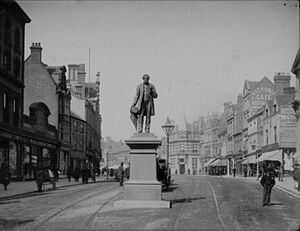
By 1851, Reading's population was 21,500. The year before, the Reading Union Water Company began building a system to solve the lack of safe drinking water. Untreated water was pumped to the Bath Road Reservoir. It was then filtered and sent by gravity to homes. The work was finished by 1852.
The Summer Assizes courts moved from Abingdon to Reading in 1867. This made Reading the main county town of Berkshire. This decision was officially approved in 1869. The town became a county borough in 1888. A permanent military base was set up in the city when Brock Barracks was finished in 1881.
By 1900, the population was 59,000. Many of Reading's houses are terraced, showing its growth in the 1800s. The town became famous for its "Three Bs": beer (from 1785 to 2010, by H & G Simonds), bulbs (for plants, from 1837 to 1974, by Suttons Seeds), and biscuits (from 1822 to 1976, by Huntley and Palmers). In the 1800s, the town also made 'Reading Sauce'. This was a sharp sauce with onions, spices, and herbs, much like Worcestershire Sauce.
Reading in the 1900s and 2000s
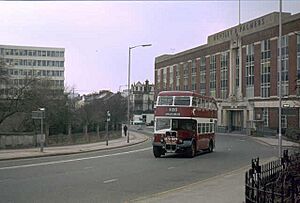
Compared to many other English towns, Reading did not suffer much damage during the two World Wars. However, many of its citizens died or were hurt in the conflicts. Their names are remembered on the Berkshire War Memorial. One major air raid happened on February 10, 1943. A single German plane attacked the town center, killing 41 people and injuring over 100. Most of these were from one bomb that hit the crowded People's Pantry restaurant. In 1947, Phoebe Cusden, who was then the Mayor of Reading, visited Düsseldorf, Germany. She saw that the city was suffering greatly. She gathered support from Reading residents and sent food, clothing, and toys to Düsseldorf. The next year, she invited six Düsseldorf children to stay in Reading for three months. She also set up the Reading-Düsseldorf Association to keep the connection going, which it still does today.
The town kept growing in the 1900s. In 1911, it took in Caversham, which was across the River Thames in Oxfordshire. This growth can be seen in the many semi-detached houses built in the 1920s. In the 1950s, Reading expanded again, joining Woodley, Earley, and Tilehurst into the town. Miles Aircraft in Woodley was an important local company from the 1930s to the 1950s. The Lower Earley development, started in the 1970s, was the largest private housing project in Europe. This made Reading's urban area reach the M4 motorway, which is now the town's southern border. More housing developments have added modern commuter houses around Reading. There are also 'out-of-town' shopping hypermarkets.
At the end of 1966, the Yield Hall multi-storey car park opened. It had covered space for 522 cars. It was designed so that cars going up were separate from cars going down.
The local shopping center, The Oracle, opened in 1999. It is named after a 17th-century workhouse that used to be on part of the site. This workhouse was funded by money left by John Kendrick. The Oracle shopping center has three floors of shops and created 4,000 jobs, boosting the local economy.
Reading is the largest town in the United Kingdom that does not have city status. Reading has tried to become a city three times: in 2000 for the new millennium, in 2002 for Queen Elizabeth II's Golden Jubilee, and in 2012 for her Diamond Jubilee. All three attempts were not successful.
See also


